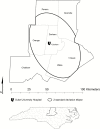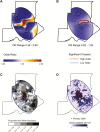Geographic Disparities in Cytomegalovirus Infection During Pregnancy
- PMID: 28201739
- PMCID: PMC5907865
- DOI: 10.1093/jpids/piw088
Geographic Disparities in Cytomegalovirus Infection During Pregnancy
Abstract
Background: Cytomegalovirus (CMV) is the most common infectious cause of fetal malformations and childhood hearing loss. CMV is more common among socially disadvantaged groups, and it clusters geographically in poor communities. We conducted a geospatial analysis of chronic and primary CMV infection among pregnant women around Durham, NC.
Methods: We performed a geospatial analysis of subjects from an ongoing study of CMV infection among pregnant women using geographic information systems and spatial statistics. Subjects were categorized on the basis of results of their CMV immunoglobulin G avidity testing as seronegative, seropositive, or primary infection. We used generalized additive models to analyze the spatial distributions of individuals who fell into each category and to control for confounders such as race and age. We used a generalized estimating equation to correlate community-level variables with CMV status.
Results: Of 3527 pregnant women aged 15 to 59 years, 93.4% were either white or black. CMV seropositivity was significantly more common among non-Hispanic white subjects than among minority subjects (odds ratio, 3.76 [95% confidence interval, 3.25-4.34]). We identified a cluster in which women had elevated odds of CMV seropositivity in the urban neighborhoods of Durham. Cases of primary CMV infection were more common in areas with higher-than-average CMV seroprevalence. Neighborhood median family income was associated inversely with the prevalence of chronic CMV.
Conclusions: We found a high prevalence of CMV seropositivity in urban low-income neighborhoods among pregnant women, particularly among racial and ethnic minorities. Seronegative pregnant women from these communities might be at heightened risk for primary CMV infection.
Keywords: African American; black; cluster; cytomegalovirus; disparity; epidemiology; generalized additive model; geographic information system (GIS); poverty; segregation; serology; spatial epidemiology.
© The Author 2017. Published by Oxford University Press on behalf of The Journal of the Pediatric Infectious Diseases Society. All rights reserved. For permissions, please e-mail: journals.permissions@oup.com.
Figures



Similar articles
-
Neighborhood Disadvantage is Associated with High Cytomegalovirus Seroprevalence in Pregnancy.J Racial Ethn Health Disparities. 2018 Aug;5(4):782-786. doi: 10.1007/s40615-017-0423-4. Epub 2017 Aug 24. J Racial Ethn Health Disparities. 2018. PMID: 28840519 Free PMC article.
-
Seroprevalence of cytomegalovirus infection in the United States, 1988-1994.Clin Infect Dis. 2006 Nov 1;43(9):1143-51. doi: 10.1086/508173. Epub 2006 Oct 2. Clin Infect Dis. 2006. PMID: 17029132
-
Cytomegalovirus Infection among Pregnant Women in Beijing: Seroepidemiological Survey and Intrauterine Transmissions.J Microbiol Biotechnol. 2017 May 28;27(5):1005-1009. doi: 10.4014/jmb.1612.12020. J Microbiol Biotechnol. 2017. PMID: 28285497
-
Review of cytomegalovirus seroprevalence and demographic characteristics associated with infection.Rev Med Virol. 2010 Jul;20(4):202-13. doi: 10.1002/rmv.655. Rev Med Virol. 2010. PMID: 20564615 Review.
-
[Decreasing seropositivity of cytomegalovirus of pregnant women in Japan].Nihon Rinsho. 1998 Jan;56(1):193-6. Nihon Rinsho. 1998. PMID: 9465689 Review. Japanese.
Cited by
-
Seroprevalence of Cytomegalovirus Among Pregnant Women at Kawempe National Referral Hospital, Uganda: A Cross-sectional Study.Open Forum Infect Dis. 2025 Mar 10;11(Suppl 3):S200-S205. doi: 10.1093/ofid/ofae604. eCollection 2024 Dec. Open Forum Infect Dis. 2025. PMID: 40070698 Free PMC article.
-
Re-Evaluating Human Cytomegalovirus Vaccine Design: Prediction of T Cell Epitopes.Vaccines (Basel). 2023 Oct 24;11(11):1629. doi: 10.3390/vaccines11111629. Vaccines (Basel). 2023. PMID: 38005961 Free PMC article.
-
Neighborhood Disadvantage is Associated with High Cytomegalovirus Seroprevalence in Pregnancy.J Racial Ethn Health Disparities. 2018 Aug;5(4):782-786. doi: 10.1007/s40615-017-0423-4. Epub 2017 Aug 24. J Racial Ethn Health Disparities. 2018. PMID: 28840519 Free PMC article.
-
Early childhood undernutrition increases risk of hearing loss in young adulthood in rural Nepal.Am J Clin Nutr. 2018 Feb 1;107(2):268-277. doi: 10.1093/ajcn/nqx022. Am J Clin Nutr. 2018. PMID: 29425280 Free PMC article.
-
Application of Spatial Analysis on Electronic Health Records to Characterize Patient Phenotypes: Systematic Review.JMIR Med Inform. 2024 Oct 15;12:e56343. doi: 10.2196/56343. JMIR Med Inform. 2024. PMID: 39405525 Free PMC article.
References
-
- Lazzarotto T, Guerra B, Lanari M, et al. New advances in the diagnosis of congenital cytomegalovirus infection. J Clin Virol 2008; 41:192–7. - PubMed
MeSH terms
Substances
LinkOut - more resources
Full Text Sources
Other Literature Sources
Medical

